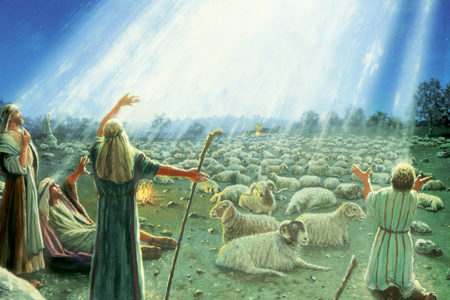We Beheld His Glory
And the Word became flesh and dwelt among us, and we beheld His glory, the glory as of the only begotten of the Father, full of grace and truth (Jn. 1:14).
At Christmas we celebrate what may be the single most remarkable and mysterious event in all of history—the incarnation of Jesus Christ. God sent his Son to be born of a virgin, that He might die for the sins of all mankind.
But sometimes we tend to overlook the fact that Jesus came for another reason as well: to reveal God. It has always been God’s desire that people know Him; and through the ages, He has gone to great lengths to reveal Himself to the human race.
After He created the first man and woman (Adam and Eve) in His own image, God walked with Adam in the cool of the day (Gen. 3:8). He was revealing Himself to Adam so that Adam and Eve would respond to Him in loving, worshipful submission. (He also walked with Enoch and revealed Himself to Noah.) God created humanity to live in knowledgeable fellowship with its Creator.
Unfortunately, many people are not interested in having a relationship with God and refuse to submit to Him. The apostle Paul wrote his letter to the Romans in the first century A.D., but it reads as though it were written today:
Although they knew God, they did not glorify Him as God, nor were thankful, but became futile in their thoughts, and their foolish hearts were darkened. Professing to be wise, they became fools, and changed the glory of the incorruptible God into an image made like corruptible man—and birds and four-footed animals and creeping things. Therefore God also gave them up to uncleanness, in the lusts of their hearts, to dishonor their bodies among themselves, who exchanged the truth of God for the lie, and worshiped and served the creature rather than the Creator, who is blessed forever. Amen (1:21–25) .
Paul added, “For since the creation of the world His invisible attributes are clearly seen, being understood by the things that are made, even His eternal power and Godhead, so that they [people] are without excuse” (v. 20). Though many “suppress the truth in unrighteousness” (v. 18), all people have access to the knowledge of God because God has shown that truth to them through creation (v. 19).
In fact, He has always had ways of manifesting His glory—His person and nature—to the people He created. The first and most continuous way is through creation: “The heavens declare the glory of God; and the firmament shows His handiwork” (Ps. 19:1).
In addition to this general revelation, God has consistently provided special revelation to men. The God of glory appeared to Abraham in Mesopotamia (Acts 7:2), calling him out of that country. Then God appeared to him at least four more times (Gen. 12:7; 15:17; 17:1; 18:1), encouraging Abraham’s walk of faith and drawing him into an ever-deepening relationship with Him. He also appeared to Abraham’s son Isaac and Isaac’s son Jacob to reiterate the everlasting covenant He had made with them and their physical descendants and to stimulate their faith.
Next the Lord appeared to Moses in a burning bush, calling him to return to Egypt as God’s instrument of redemption for His people. God told Moses to tell Israel, “The Lᴏʀᴅ God of your fathers, the God of Abraham, of Isaac, and of Jacob, appeared to me” (Ex. 3:16). Later Moses asked God for an even greater manifestation of His glory (33:18), and God accommodated him.
At one point, God’s glory was manifested in Moses’ face for all Israel to behold. And so things continued throughout the 40 years the children of Israel wandered in the wilderness en route to their Promised Land (34:29–35).
When the Tabernacle was constructed in the wilderness, God came to dwell in its Holy of Holies, between the cherubim above the mercy seat. All Israel beheld His glory, manifested by a pillar of cloud by day and fire by night. God was revealing Himself to His people.
When Solomon dedicated the Temple in Jerusalem, “the cloud filled the house of the Lᴏʀᴅ, so that the priests could not continue ministering because of the cloud; for the glory of the Lᴏʀᴅ filled the house of the Lᴏʀᴅ” (1 Ki. 8:10–11).
Others also received personal manifestations of God’s glory from time to time (Isa. 6:1; Dan. 7:9–14). God continued to manifest His glory to the Israelites until they went into captivity in Babylon in the sixth century B.C.:
The glory of the Lᴏʀᴅ departed from the threshold of the temple and stood over the cherubim. And the cherubim lifted their wings and mounted up from the earth in my sight. When they went out, the wheels were beside them; and they stood at the door of the east gate of the Lᴏʀᴅ’s house, and the glory of the God of Israel was above them (Ezek. 10:18–19).
In Ezekiel 11:22–23, the glory of the Lord ascended from the Mount of Olives into heaven; and God essentially wrote “Ichabod” over Israel’s sanctuary, meaning “the glory has departed.”
Israel still had creation and the Scriptures, but God seems to have removed the personal manifestation of His glory for almost 600 years until the eternal Word stepped into history in the form of Jesus Christ.
Coming as Israel’s Messiah and Redeemer, Jesus was also commissioned to reveal God’s glory to humanity. Though He did not manifest the external brilliance of God’s glory (Isa. 53:2–3), He portrayed God’s character through a perfect balance of “grace and truth”:
God, who at various times and in various ways spoke in time past to the fathers by the prophets, has in these last days spoken to us by His Son, whom He has appointed heir of all things, through whom also He made the worlds; who [is] the brightness of His glory and the express image of His person (Heb. 1:1–3).
The glory of God was being revealed through Jesus’ life, which He lived under the direction and control of the Holy Spirit. Jesus said He did and spoke everything just as He received it from His Father (Jn. 8:26–28; 12:49). “He who believes in Me,” He said, “believes not in Me but in Him who sent Me. And he who sees Me sees Him who sent Me” (12:44–45).
When Jesus’ disciple Philip said to Him, “Lord, show us the Father, and it is sufficient for us,” Jesus replied, “Have I been with you so long, and yet you have not known Me, Philip?” (14:8–9). Jesus then explained,
He who has seen Me has seen the Father; so how can you say, ”Show us the Father”? Do you not believe that I am in the Father, and the Father in Me? The words that I speak to you I do not speak on My own authority; but the Father who dwells in Me does the works (vv. 9–10).
The message of Christmas is the message of God’s love. It is also the message of God’s desire for us to know Him and have a personal relationship with Him. Jesus kept inviting men to come to Him—to know Him and to know His Father. The sad news is that the incarnate Word “came to His own, and His own did not receive Him” (1:11). Like many people today, they rejected Him because they were not interested in knowing God.
The good news is that “as many as received Him, to them He gave the right to become children of God, to those who believe in His name: who were born, not of blood, nor of the will of the flesh, nor of the will of man, but of God” (vv. 12–13). Jesus said, “And this is eternal life, that they may know You, the only true God, and Jesus Christ whom You have sent” (17:3).
Forty days after His resurrection, Jesus returned to heaven from the Mount of Olives. Today Christians are to live as He lived: under the direction and control of the Holy Spirit and thereby manifest God’s glory. As God dwelt in the Tabernacle in the Old Testament, so He dwells in born-again believers today and uses them as the vehicles through which men and women might come to know God.







